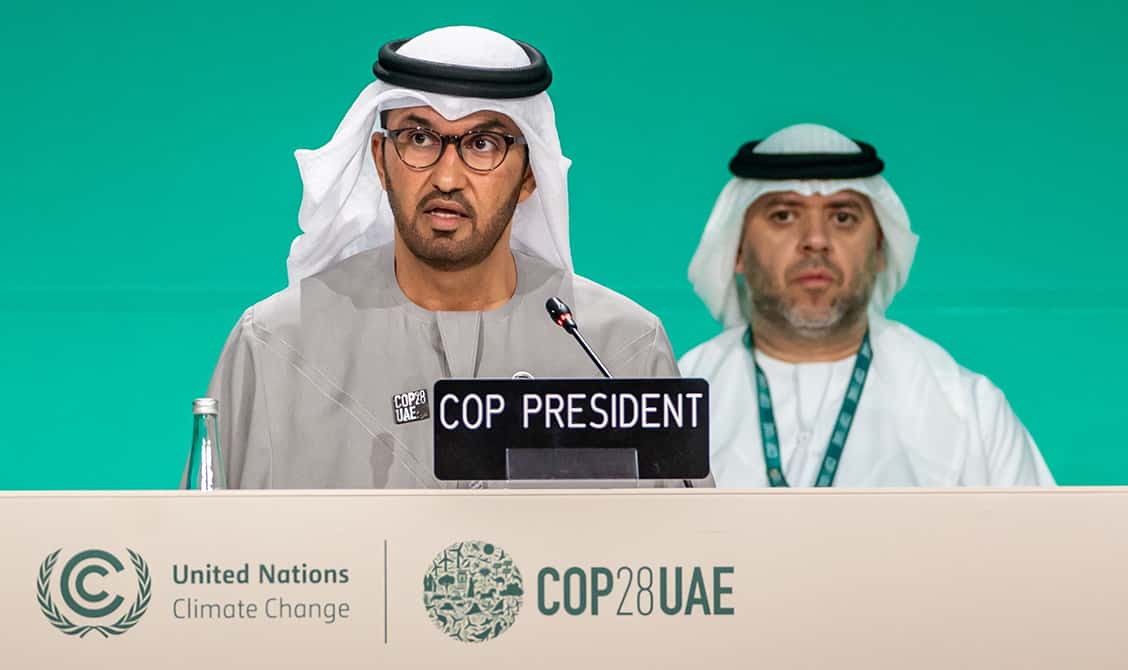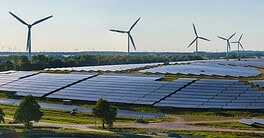Fossil fuel phaseout is now a global goal. But in other respects, the climate change conference saw few breakthroughs.
When the 28th annual UN Climate Change Conference—better known as COP28—convened in Dubai at the end of November, the future of fossil fuels was the elephant in the room. Almost 200 countries declared that a deal to phase out oil and gas production was essential to achieving the Paris Climate Accord’s target of limiting global warming to 1.5 degrees Celsius above preindustrial levels.
Pushback came promptly from oil-producing countries including host United Arab Emirates (UAE) and Saudi Arabia, which made it clear that they have no intention of cutting down on oil and gas extraction; indeed, most of them have plans to ramp up output in the coming years.
Nobody symbolized these tensions better than COP28’s president, Sultan Ahmed Al Jaber, who is also the CEO of the Abu Dhabi National Oil Company (Adnoc). While many observers had signaled a conflict of interest from the day of his appointment, oil producers and oil majors insisted they had to be part of the process. Since the world can’t suddenly stop using fossil fuels, Al Jaber argues, it needs to find ways to exploit them in a cleaner, smarter way. So, while no promise to decrease oil and gas production emerged from the conference, COP participants pledged to triple renewable energy capacity by 2030. Similarly, solutions including technology to reduce methane emissions, decarbonization projects, and hydrogen plants received a lot of attention in the conference program.
“We cannot unplug the energy setup we have today,” says Shargiil Bashir, executive vice president and chief sustainability officer at First Abu Dhabi (FAB), the UAE’s biggest bank. “We need energy between now and the future and for all the coming generations. So we need to find the sustainable solutions that can take us to that point.” Two years ago, FAB committed $75 billion in sustainable finance in the form of lending, investment, and business facilitation; and it has already delivered $27 billion in energy projects, wastewater infrastructure, and green buildings. During the conference, the bank announced an increase in commitment to $135 billion.
Money talks, however; and the amounts pledged to fight climate change were underwhelming: Participants in the conference pledged over $85 billion to climate action, announced the COP28 presidency.
This included $3.5 billion for the UN’s Green Climate Fund to assist developing countries in adapting to climate change, and $792 million to the much-discussed Loss and Damage Fund, created at COP27 in Egypt and finalized in Dubai, which will provide financial assistance to developing countries that suffer severe impacts from climate disasters.
While those amounts may sound large, they fall far short of the trillions that some observers say will be needed every year to address the effects of global warming.
“Progress was made on a number of issues” at COP28, says Fabio Natalucci, monetary and capital markets deputy director at the International Monetary Fund (IMF), “including the operationalization of the Loss and Damage Fund, but there is still a gap between ambition and action.”
“Financial pledges remain too weak,” says political scientist François Gemenne, president of the Scientific Council of the Foundation for Nature and Man and a member of the UN Intergovernmental Panel on Climate Change. “That will need to be the focus of COP29.”
In most cases, the actual funding mechanisms to ensure the money gets to the people who need it the most are as yet unclear. One major issue, especially for developing nations, is what part of the amounts pledged will be distributed as loans that could end up increasing the debt burden of already weak economies.
“We call for deeper and fairer commitments, especially for the countries of the South,” says Hassanein Hiridjee, CEO of the Axian Group, a pan-African real estate, financial services, technology, telecom and energy company. “We need our realities to be better taken into consideration, and we need concrete actions.” In 2023, Africa received only 2% of global investments in renewable energies, Hiridjee notes.
Far from making substantial progress, “COP28 has come to an end with increasing challenges in achieving climate action targets with decreasing commitments, rising conflicts, and fragility,” says Mohammad Jamal Alsaati, special adviser to the president of the Islamic Development Bank.
A Glass Half Full?
After much back and forth, the final statement issued before the conference broke up on December 12 delivered a road map for “transitioning away from all fossil fuels … to reach net zero by 2050.” For many present in Dubai, the lack of a commitment to fossil fuel phaseout was a hard blow.
“Governments have agreed, after 28 attempts, what we’ve known for decades—we must reduce fossil fuel use,” Mike Davis, CEO of the UK-based NGO Global Witness, said in a statement to the press shortly afterward. “At a COP run by petrostates and flooded by thousands of oil and gas lobbyists, that simple acknowledgment is a hard-won victory.” Davis added that “we should be realistic about what the failure to agree a phaseout means: fossil fuels forever.”
Other observers, however, prefer to see the glass half full, noting that for the first time, a COP agreement used the term “fossil fuel.”
“I see the COP28 deal as a turning point toward a fossil-free world in 2050,” says Gemenne. “Sure, it has some weaknesses, but making 197 countries, which are completely different from one another, with different constraints and resources, agree on a common pathway for the future is nothing short of a diplomatic miracle.”
Another big challenge of COP28 was to bring the private sector to the table at a time when borrowing costs are high; and in this, COP28 had some progress to report.
Shortly after the conference opened, the UAE announced the creation of Alterra, a new private-sector fund with $30 billion in hand and that aims to gather $250 billion by 2050 to encourage nature-positive finance. Banks and financial institutions expressed a desire to join in. The UAE banking sector said it expected to mobilize over $270 billion in green finance by 2030.
“There is an urgent need to mobilize private capital to turn ambition into reality,” says the IMF’s Natalucci. “According to our estimates, climate mitigation investment in emerging markets and developing economies needs to increase to $2 trillion a year between now and 2030; and between 80% and 90% of that needs to be financed by the private sector, up from the current 40%. In terms of flows, it is five times the current flows. If you look at total investment in these countries, it’s a four-times increase, from 3% to 12%. However you slice it, there needs to be a lot more private capital.”
A deeper partnership between the public and the private sector is also critical, says FAB’s Bashir, bringing together commercial banks, development banks, and governments. “We need the policymakers to be supportive,” he argues.
While the conference delivered on some of the goals the UAE had set for COP28, it remains to be seen how the gathering event’s promises—however modest—will materialize on the ground.
“An agreement is only as good as its implementation,” said President Al Jaber during the closing session, passing the responsibility on to the next COP host, Azerbaijan.




